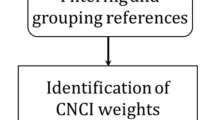Abstract
Here we show a longitudinal analysis of the overall prestige of first quartile journals during the period between 1999 and 2009, on the subject areas of Scopus. This longitudinal study allows us to analyse developmental trends over times in different subject areas with distinct citation and publication patterns. To this aim, we first introduce an axiomatic index of the overall prestige of journals with ranking score above a given threshold. Here we demonstrate that, between 1999 and 2009, there was high and increasing overall prestige of first quartile journals in only four areas of Scopus. Also, there was high and decreasing overall prestige of first quartile journals in five areas. Two subject areas showed high and oscillating overall prestige of first quartile journals. And there was low and increasing overall prestige in four areas, since the 1999.







Similar content being viewed by others
References
Bergstrom C. (2007). Eigenfactor: Measuring the value and prestige of scholarly journals. College and Research Libraries News, 68(5), 314–316.
Bollen, J., Rodriguez, M.A., & van de Sompel, H. (2006). Journal status. Scientometrics, 69(3), 669–687.
Bornmann, L. (2010). Towards an ideal method of measuring research performance: Some comments to the Opthof and Leydesdorff (2010) paper. Journal of Informetrics, 4(3), 440–443.
Chakravarty, S. R. (1983). A new index of poverty. Mathematical Social Sciences, 6, 307–313.
Garcia, J. A., Rodriguez-Sanchez, R., & Fdez-Valdivia, J. (2011). The prestige gap of journals below a given threshold. The Journal of Informetrics (Submitted).
Garfield E. (2006). The history and meaning of the journal impact factor. JAMA-Journal of the American Medical Association, 295 (1), 90–93.
González-Pereira, B., Guerrero-Bote, V. P., & Moya-Anegón, F., (2010). A new approach to the metric of journals’ scientific prestige: The SJR indicator. Journal of Informetrics, 4(3), 379–391.
Kalaitzidakis, P., Stengos, T., & Mamuneas, T. P. (2003). Rankings of academic journals and institutions in economics. Journal of the European Economic Association, 1(6), 1346–1366.
Kapeller, J. (2010). Some critical notes on citation metrics and heterodox economics. Review of Radical Political Economics, 42(3), 330–337.
Kelchtermans, S., & Veugelers, R. (2011). The great divide in scientific productivity: Why the average scientist does not exist. Industrial and Corporate Change, 20(1), 295–336.
Kodrzycki, Y. K., & Yu, P. (2006). New approaches to ranking economics journals. Contributions to Economic Analysis and Policy, 5(1), Art. 24.
Lee, J., Cassano-Pinche, A., & Vicente, K. J. (2005). Bibliometric analysis of human factors (1970–2000): A quantitative description of scientific impact.Human Factors: The Journal of the Human Factors and Ergonomics Society, 47(4), 753–766.
Leydesdorff, L., Moya-Anegón, F., & Guerrero-Bote, V. P. (2010). Journal maps on the basis of Scopus data: A comparison with the journal citation reports of the ISI. Journal of the American Society for Information Science and Technology, 61(2), 352–369.
Liebowitz Stanley, J., & Palmer, J. P. (1984). Assessing the relative impacts of economics journals. Journal of Economic Literature, 1, 77–88.
Ma, N., Guan, J., & Zhao, Y. (2008). Bringing PageRank to the citation analysis. Information Processing and Management, 44(2), 800–810.
Merton, R. K. (1968). The Matthew effect in science. Science, 5, 56–63.
Moed, H. F. (2010). CWTS crown indicator measures citation impact of a research group’s publication oeuvre. Journal of Informetrics, 4(3), 436–438.
Opthof, T., & Leydesdorff, L. (2010) Caveats for the journal and field normalizations in the CWTS Leiden evaluations of research performance original research article. Journal of Informetrics, 4(3), 423–430.
Palacios-Huerta I., & Volij O. (2004). The measurement of intellectual influence. Econometrica, 72(3), 963–977.
Peichl, A., Schaefer, T., & Scheicher, C. (2008). Measuring richness and poverty: A micro data application to Europe and Germany. IZA Discussion Paper no. 3790.
Pinski, G., & Narin, F. (1976). Citation influence for journal aggregates of scientific publications. Information Processing and Management, 12, 297–312.
Podsakoff, P. M., MacKenzie, S. B., Podsakoff, N. P., & Bachrach, D. G. (2008). Scholarly influence in the field of management: A bibliometric analysis of the determinants of university and author impact in the management literature in the past Quarter Century. Journal of Management, 34(4), 641–720.
Rousseau, R., & Van Hooydonk, G. (1996). Journal production and journal impact factors. Journal of the American Society for Information Science, 47, 775–780.
Rousseau, S., Verbeke, T., & Rousseau, R. (2009). Evaluating environmental and resource economics journals: A TOP-curve approach. Review of Environmental Economics and Policy, 3(2), 270–287.
SCImago Research Group. SCImago Journal and Country Rank. http://www.scimagojr.co.
Sen, A. (1976). Poverty: An ordinal approach to measurement. Econometrica, 44(2), 219–231.
Spaan, J. A. E. (2010). The danger of pseudoscience in Informetrics. Journal of Informetrics, 4(3), 439–440.
Takayama, N. (1979). Poverty, income inequality, and their measures: Professor Sen’s axiomatic approach reconsidered. Econometrica, 47(3), 747–759.
The Scopus website. http://www.scopus.com. Accessed February 2011.
van Raan Anton, F. J. (2004). Measuring science. In: F. Moed Henk, G. Wolfgang, & S. Ulrich (Eds.), Handbook of quantitative science and technology research (pp. 19–50). Dordrecht, The Netherlands: Kluwer.
van Raan, A. F.J., van Leeuwen, T. N., Visser, M. S., van Eck, N. J., & Waltman, L. (2010). Rivals for the crown: Reply to Opthof and Leydesdorff original research article. Journal of Informetrics, 4(3), 431–435.
Acknowlegdments
This research was sponsored by the Spanish Board for Science and Technology (MICINN) under grant TIN2010-15157 co-financed by European FEDER funds. Thanks are due to the reviewers for their constructive suggestions.
Author information
Authors and Affiliations
Corresponding author
Rights and permissions
About this article
Cite this article
García, J.A., Rodriguez-Sánchez, R. & Fdez-Valdivia, J. Overall prestige of journals with ranking score above a given threshold. Scientometrics 89, 229–243 (2011). https://doi.org/10.1007/s11192-011-0442-6
Received:
Published:
Issue Date:
DOI: https://doi.org/10.1007/s11192-011-0442-6




